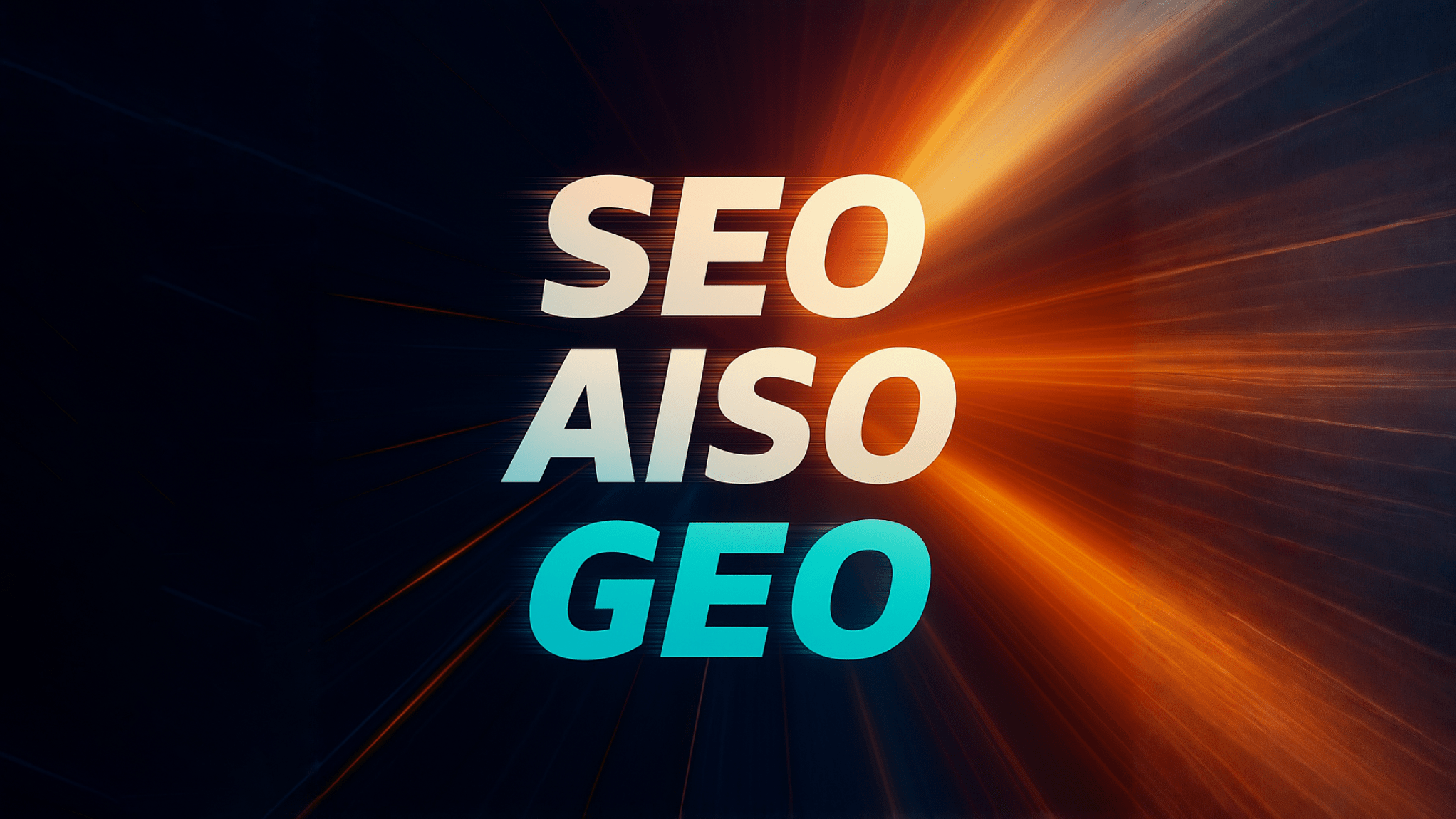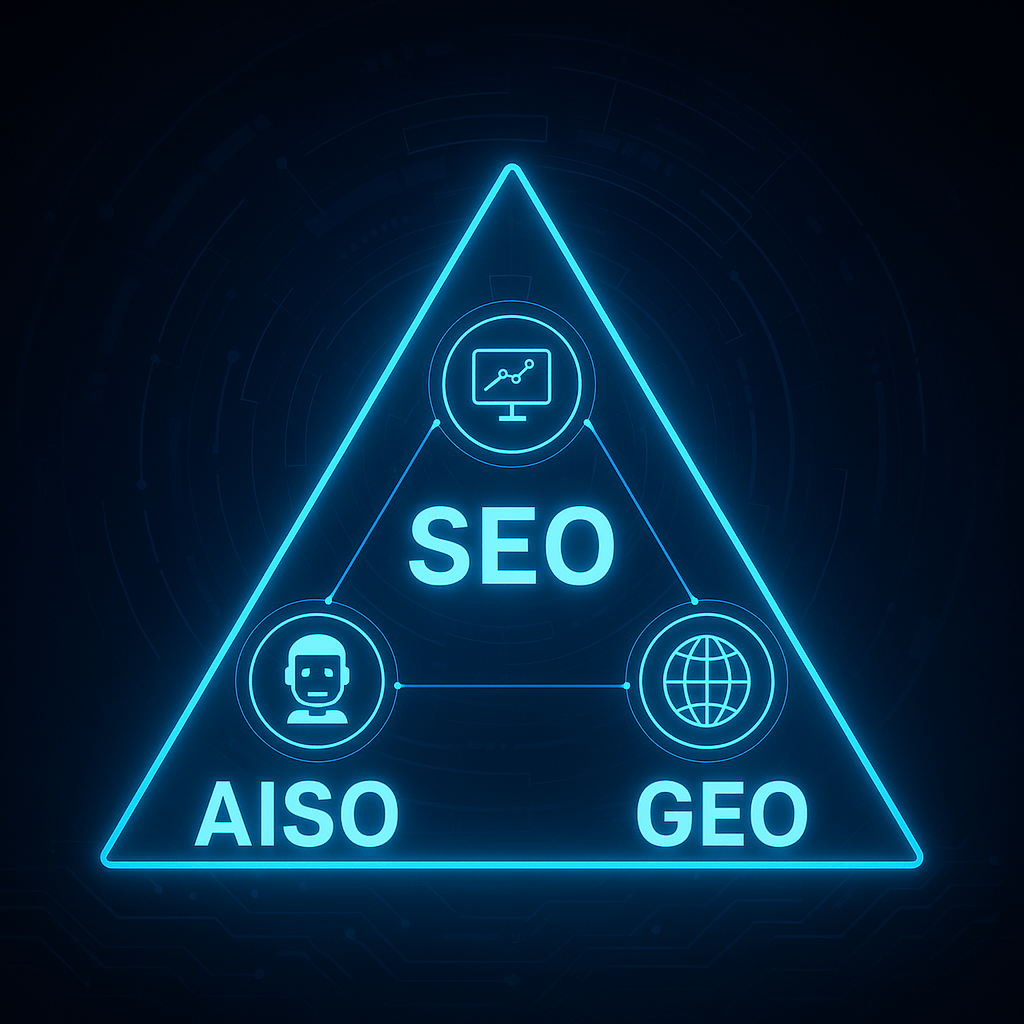

SEO vs. AISO vs. GEO: Search and AI Visibility Strategies
Online visibility is evolving. Being seen requires optimizing for Google (SEO), AI-powered answers (AISO), and generative AI (GEO).
Getting noticed online used to mean ranking high on Google. Now, with AI chatbots, voice assistants, and instant answers, the challenge has multiplied and become much more complex.
- SEO: Still vital for ranking and getting clicks from search engines.
- AISO: Optimizes your content to be the instant answer—appearing in snippets or voice responses, often with zero clicks.
- GEO: The newest frontier—ensures your content is used and cited by AI tools like ChatGPT and Google Gemini.
Why care? Over half of searches end without a click, and AI is changing how people find information.
What now? Keep your SEO strong, add clear answers for AISO, and make your content AI-friendly for GEO. Visibility now means mastering all three.
Online visibility has never been more challenging. It’s not enough to rank high on Google. Users now get answers directly from search results, voice assistants, or AI chatbots, often without ever clicking a link, and those answers are frequently generated from the top 10 traditional search results, 70%. To stay visible, you must master three overlapping strategies: SEO, AISO, and GEO.
SEO (Search Engine Optimization) is the classic approach: optimize your site’s content, structure, and authority to rank high in search engines and drive organic clicks. But with nearly 60% of searches ending in “zero clicks,” SEO alone isn’t enough.
AISO (Artificial Intelligence Search Optimization), also known as Answer Engine Optimization (AEO), focuses on making your content the instant answer. This means structuring content for featured snippets, knowledge panels, and voice responses, so your brand is visible even if users don’t visit your site. Use clear, concise answers and schema markup to increase your chances.
GEO (Generative Engine Optimization) is the newest frontier. As AI tools like ChatGPT and Google Gemini generate answers by pulling from multiple sources, GEO ensures your content is authoritative, well-structured, and easy for AI to use and cite. Think comprehensive, up-to-date, and trustworthy information.
What’s the takeaway?
You need all three: SEO to get ranked, AISO to appear in instant answers, and GEO to be included in AI-generated content. The rules of visibility have changed. Layer your strategies to stay seen in a world where users may never even click.
Deep Dive | Understanding SEO, AISO, and GEO
Change is the only constant thing in digital marketing. Not long ago, ranking #1 on Google was the ultimate goal. Today, more and more users often get their answers without ever clicking a link.
In fact, nearly 60% of Google searches in 2024 ended with zero clicks, as users found what they needed directly on the search results page. At the same time, AI-powered tools are exploding in popularity – OpenAI’s ChatGPT reached 100 million users in just two months, the fastest-growing app ever. Platforms like ChatGPT, Perplexity, Bing’s AI Copilot, and Google’s Gemini are changing how people find and consume information.
These trends signal a fundamental shift from traditional Search Engine Optimization (SEO) toward Artificial Intelligence Search Optimization (AISO) and nascent Generative Engine Optimization (GEO), which should not be confused with tagging. AISO is sometimes called AEO, short for Answer Engine Optimization, though “answer engine” is not used in conversational discussion.
So what do we mean by the terms SEO, AISO, and GEO, and how do they compare? This guide will define each concept, explore their strategic objectives, and show how each discipline capitalizes on audience behaviors to achieve digital marketing goals.
SEO vs. AISO vs. GEO in Context

From food to fashion, our patience as an audience is in short supply. Search results are no exception. People needing fast answers are using voice search or asking virtual assistants questions instead of typing, with one-third of users in the United States searching with voice.
When using voice or mobile, users often get a single spoken answer or a quick snippet, not a list of blue links. Likewise, on desktop and mobile, Google increasingly displays featured snippets, knowledge panels, People Also Ask boxes, and other rich results that satisfy queries directly on the results page.
These on-SERP answers contribute to the zero-click trend, delivering key information that leaves users satisfied without clicking through to a website.
At the same time, the rise of AI answer engines, think ChatGPT-style Q&A bots and Google’s Gemini answers, means users can get conversational, detailed answers synthesized from multiple sources.
For example, Bing’s AI Copilot can answer complex questions by pulling information from various sites, often citing them, and Google displays an AI summary at the top of search results.
Answer engines are becoming the go-to for quick facts, definitions, and simple queries. And generative AI tools can handle even multi-part questions by composing an answer on the fly. In short, search has evolved: it’s no longer just “10 blue links” and SEO; it’s also about providing AI answers (AISO) and feeding AI algorithms (GEO).
You risk losing visibility if your search strategy relies solely on traditional SEO without addressing these changes. In the following sections, we’ll break down SEO vs. AISO vs. GEO, comparing their goals, tactics, and how they meet modern user intent.
(For a deep dive into how SEO is changing in the face of these trends, see our recent article The State of SEO in 2024, which explores how businesses must produce, measure, and adapt content to stay competitive.)
What is SEO (Search Engine Optimization)?
![]()
Search Engine Optimization (SEO) is the classic foundation of online visibility. SEO tactics increase the likelihood of a website ranking at the top of Google or Bing, the most significant search engines. The strategic objective of SEO is simple: drive organic traffic to your site by ranking high for relevant keywords.
If your site appears on the coveted first page, especially in the top few results, users are more likely to click through to your content.
How SEO Works
Over the past two decades, SEO professionals have developed various techniques to appeal to opaque search engine algorithms.
- On-Page SEO: Optimizing page content and HTML elements. This means crafting relevant title tags and meta descriptions, using headings with target keywords, and ensuring the text on the page is high-quality and matches user search intent. On-page SEO is about clearly signaling what your page is about so search engines can index it properly.
- Off-Page SEO: Building your site’s authority and reputation through backlinks. When reputable, relevant websites link to your content, it boosts your domain’s credibility in Google’s eyes, based on Google’s original PageRank algorithm. Off-page SEO often involves content marketing, outreach, and digital PR to earn quality links.
- Technical SEO: Improving the website’s technical health so search engines can crawl and index it efficiently. This includes having a fast page load speed, mobile-friendly design, clean URL structures, proper use of XML sitemaps and robots.txt, and fixing any indexing errors. A technically sound site provides a better user experience (UX), making it easier for Google’s bots to understand your content.
- User Experience & Core Web Vitals: Modern SEO overlaps with UX optimizations. Google rewards sites that are secure (HTTPS), mobile-optimized, and fast. Its Core Web Vitals metrics, like page load speed and stability, are now ranking factors. In 2024, optimizing for user experience isn’t just nice-to-have; it’s necessary for SEO success.
- Content Strategy: “Content is king” remains true. SEO involves researching keywords and topics your audience cares about, then creating and updating valuable, in-depth content around those queries. This might include blogging, resource articles, infographics, videos, and any content that answers users’ questions and provides solutions. The content should be organized logically to help users and search engines navigate it.
- Local SEO: For businesses serving specific locations, SEO includes local tactics like maintaining a Google Business Profile, earning reviews, and using location-specific keywords. The goal is to appear in local searches and map packs, capturing nearby customers.
In practice, SEO is about balancing all these elements to make your site the most relevant, trustworthy result for target searches. A solid SEO strategy enhances website performance, discoverability, and sustainable growth, continually bringing in interested visitors.
But, and it’s big, SEO’s traditional focus is on getting the click, most often through a high search results position. This is where AISO and GEO diverge.
What is AISO?
![]()
Artificial Intelligence Optimization (AISO) is the new digital discipline of optimizing your content to provide direct answers for users’ queries, especially in contexts where the search platform or assistant delivers the answer immediately.
If SEO’s aim is to get users onto your website, AISO’s aim is often to have your content be the answer the user receives, whether or not they click through. In other words, AISO is about claiming that “Position Zero” spot, those featured snippets, instant answers, and voice responses that users see or hear first.
Traditional SEO focuses on ranking web pages; AISO ensures your content is formatted for immediate retrieval in featured snippets, knowledge panels, FAQ snippets, and voice search results. The strategic objective of AISO is to satisfy the user’s query right then and there.
Why is AISO Important?
This concept arose as user behavior shifted toward quick answers. Think about when you ask your phone, “What’s the weather today?” or “Who won the game last night?”
You expect the answer to be spoken or displayed immediately, not a list of websites. Similarly, if you type a question into Google, such as “How many ounces in a cup?” Google often shows the answer at the top of the results in a snippet, so you don’t need to click anything.
AISO is all about capturing those answer opportunities. With zero-click searches now over half of them, mastering AISO helps ensure your brand still appears in front of users even when they don’t click through to anyone’s site.
Key AISO Techniques
Featured Snippet Optimization
Featured snippets are the highlighted answer boxes at the top of some Google results. To get featured, your content must be concise, well-structured, and directly answer the query. AISO involves formatting content in a snippet-friendly way. For example, if the query is “steps to change a tire,” a blog post optimized for AISO might include a clear list of step-by-step instructions. Providing definitions at the start of an article or including a Q&A-style section can also help. The payoff? If you win the snippet, you become the go-to answer. Over 40% of voice search answers actually come from featured snippets on Google.
Common snippet formats
- Paragraphs featuring a quick explanation
- Lists of steps, rankings
- Tables
Voice Search Optimization
Voice queries are typically longer and more conversational than typed ones, often phrased as full questions (“How do I…”, “What is the best…”, “Why does…?”).
AISO means aligning your content with natural language questions. This can involve incorporating FAQ sections on your pages, with actual questions as headings, and answering them clearly, or using a conversational tone in your writing. It also means thinking about long-tail keywords that resemble how people speak. For example, a traditional SEO keyword might be “coffee benefits”; an AISO/voice-friendly approach would include a question like “What are the health benefits of drinking coffee?” in the content.
Optimizing for voice also involves ensuring your site is mobile-friendly since many voice searches happen on mobile, and using structured data so that voice assistants can easily parse your content.
Structured Data & Schema Markup

AISO relies heavily on structured data (schema markup) to give search engines explicit info about your content. Adding schema.org markup for FAQs, how-tos, recipes, local business info, etc., helps Google and other platforms understand the context and siphon the correct info for answers.
For instance, an FAQ schema can highlight a question-answer pair on your page, increasing the chance that Google will show that Q&A directly on the results page. Marking up a product with the Review schema might land you in Google’s Knowledge Panel or a spoken answer via Google Assistant.
Structured data essentially speaks in the search engine’s “native language,” saying, “here’s the question, and here’s the answer.” Both SEO and AISO benefit from schema, but it’s crucial for AISO because it shows your page’s ability to provide a snippet-worthy answer.
Concise, Direct Content
With AISO, brevity and clarity are golden. You still want comprehensive content overall, Google won’t trust a flimsy page, but you should also surface the direct answer up front.
AISO best practice is to answer the core question in the first paragraph or two, then use the rest of the content to provide details, examples, and additional context. This way, the answer engine can grab the quick info, and if the user wants more, they’ll still click through. AISO is often described as “giving users the short answer and the option to get the long answer.” You serve both types of user intent.
AISO doesn’t exist in a vacuum separate from SEO; in fact, they overlap. Many SEO fundamentals, like good content, keyword research, and fast-loading pages, also aid AISO.
The difference is in focus: SEO’s end goal is a site visit, AISO’s end goal is an answer. Some businesses worry that the user won't bother visiting their site if they provide the complete answer via snippet or voice.
"While the immediate impact of AI in search is being quantified as fewer visits to websites, the qualitative results are AI searches rewarding brands that deliver clear, authoritative, and well-structured answers online that are tailored for specific customer needs," said Steve Fowler, Director of Client Marketing at DBS Interactive. "AI filters out the noise and casual 'window shoppers’ so those who do actually click through from AI search results to visit your site are likely far more qualified and ready to start a sales conversation."
It’s true AISO can sometimes reduce clicks. However, being the trusted answer can significantly enhance your brand authority and position as an industry thought leader. Users might not click immediately, but they remember the source.
For example, if your industrial product or service website consistently provides the best answers, a user may seek out your brand for more detailed info later. The quality of those visits will be higher, with more potential for engagement.
Also, featured snippets often attract clicks when users want to “read more” beyond the brief answer included in the snippet. In short, AISO prioritizes fulfilling the immediate intent of the search, especially for informational or local queries, while indirectly supporting the longer game of brand visibility and trust.
"AI results filter out the noise and casual 'window shoppers’ so those who do actually click through from AI search results to visit your site are likely far more qualified and ready to start a sales conversation."
- Steve Fowler, Marketing Director
Businesses are taking AISO seriously as search drifts from links on a search engine result page (SERP). You’ll even find specialized Answer Engine Optimization services, for example, agencies offering to optimize your site for voice search and featured snippets.
If you lack in-house expertise, working with an AISO-focused agency like DBS Interactive can help you implement these tactics. And importantly, AISO is complementary to SEO, not a replacement.
A strong digital strategy incorporates traditional SEO to drive traffic and AISO so that you capture those answers and don’t lose audience to a competitor’s snippet.
(For further reading on how voice search is changing optimization strategies, see our post on Voice Search Statistics and Emerging Trends. It offers eye-opening stats on voice query growth and tips on adapting your content.)
What is GEO (Generative Engine Optimization)?

As AI becomes woven into search, a new concept has surfaced: Generative Engine Optimization (GEO). This is the cutting-edge practice of optimizing your content to be discovered, utilized, and cited by AI-driven search engines and generative answer platforms.
In simple terms, GEO is about making your content “AI-ready” so that when someone asks a question using a tool like ChatGPT or Google, your information is what gets woven into the answer.
Generative engines (the “GE” in GEO) refer to AI systems that don’t just retrieve information but generate answers or content.
Examples include large language model chatbots such as ChatGPT, Bing Chat, Bard/Gemini, and any AI-powered search that gives a synthesized response, like the summary boxes in Google’s AI Overviews.
Unlike a traditional search engine, which might show 10 separate results for the user to choose from, a generative AI search might compile those sources and present a unified answer. This means the AI is doing much of the work a user once did, clicking and reading behind the scenes.
From an optimization standpoint, the question becomes: how do I ensure the AI chooses my content as part of its answer?
GEO Definition
One definition from industry experts is: Generative Engine Optimization is a new approach to boosting visibility in AI-driven search. It focuses on aligning your content with the needs of generative AI models, which produce detailed, context-rich responses to user queries.
In practical terms, GEO targets AI search experiences like Google’s AI Overviews and chatbots, rather than the classic page-ranking algorithm.
Traditional SEO was about keywords and backlinks. GEO is about context, quality, and being the kind of content AI wants to pull in.
Generative search continues gaining momentum as innovators define new strategies and refine best practices. Like the shifting sands of SEO, GEO is evolving. A best practice today may be irrelevant tomorrow.
Emerging GEO Strategies and Principles
- Focus on Content Depth and Quality: AI models aim to give comprehensive answers. They’re more likely to use thorough, well-researched, and authoritative content. For example, if a user asks, “How do I improve my website’s accessibility and SEO simultaneously?” a generative engine might compile advice from multiple sources.
Shallow content may be ignored, whereas AI may draw heavily from a detailed guide with concrete tips. GEO strategy means investing in high-quality content that covers in-depth topics and is updated with current information. It’s less about singular keywords and more about covering the context and entities around a topic.
- Structured and Organized Information: Much like AISO, generative AI prefers well-structured content. This doesn’t just mean using headings and lists, though that helps.
It means logical flow and clear sections that an AI can identify as relevant to secondary questions and answers. Essentially, write as if you’re feeding a fact to the AI.
Using semantic HTML, proper use of header tags, lists, and tables where appropriate, can assist AI in parsing your content. Some experts suggest that writing in a style that’s easy to parse, short paragraphs, and straightforward language is like “writing content as if you’re training an AI.”
The AI isn’t just looking for a snippet.
- Authority and Accuracy (E-E-A-T): Generative AI models tend to hallucinate or mix information. To counter this, they are often designed to favor content with signals of expertise, authority, and trustworthiness, think Google’s E-E-A-T guidelines.
GEO entails demonstrating your authority: this could mean citing sources within your content (to show it’s fact-based), having author bios with credentials, and getting quality backlinks (yes, backlinks likely still matter in an AI context as a proxy for trust).
If an AI is choosing between two sources to quote, it might lean toward the one from a recognized authority, like an .edu site or a well-known industry publication. Ensure accuracy and clarity to avoid confusing the AI.
- Data Markup and Feeds: In some cases, generative search might pull from structured data sources or APIs. For example, AI may use Google’s knowledge graph or factual tables to answer queries about product specs. If relevant, providing data to these official sources like Google’s dataset schema, or submitting info to Wikipedia/Wikidata, etc., can be part of GEO.
This is more specialized, but worth noting: GEO is not just about traditional web pages. It might involve ensuring your data or content is present where AI systems look, like being part of common datasets or Q&A knowledge bases. As generative search evolves, businesses may even supply AI-ready content feeds. For example, Google has talked about ways publishers might mark up content specifically for AI consumption in the future.
- Adapt Content for Multi-Turn Conversations: Generative AI tools often allow follow-up questions, e.g., you ask one question, then a follow-up to dig deeper. GEO may involve anticipating these deeper questions and ensuring your content answers them. For instance, if the initial query is “best budget smartphones 2025” and you have an article listing those, the user might next ask the AI, “Which of those has the best camera?” If your content includes comparative data or a section about camera quality, the AI can use it to answer the follow-up. In essence, think about user intent layers, not just the first question, but the second and third that might come after. This forward-thinking approach, similar to FAQ usage in AISO, can make your content more valuable to generative systems.
GEO Key Performance Indicators
Measuring GEO success is a new challenge. Unlike SEO, where you can track rankings and clicks in analytics programs like GA4, or AISO, where you can see if you got a featured snippet, generative AI answers can sometimes use your info without an explicit link.
Some AI search implementations, like Bing Chat, cite sources with clickable footnotes, which you can track via referral analytics, which may look like this: bing.com/chat in your analytics.
Google’s AI Answers currently displays clickable website names that are generated by the answer. As part of a GEO strategy, you’ll want to monitor these emerging referral sources and mentions.
If Bing’s AI or another tool cites you, that’s a sign you’re doing something right. Additionally, pay attention to any brand mentions or increases in branded search that might result from people seeing your brand in AI results.
Some of these metrics aren’t fully mature, but keeping an eye on them will help you gauge if your content is being picked up.
Working Together
It’s not a pitched battle between GEO, SEO, and AISO. There’s an overlap. The foundation is good SEO, technical health, and quality content. AISO-style structuring (concise answers, schema) helps. GEO refines these elements through the prism of AI-driven search evolution.
Just as featured snippets didn’t kill SEO but changed it, the rise of generative answers doesn’t eliminate the need for optimization. It requires new tactics.
The Elephant in the Room

One big question businesses have is: Will generative AI search reduce traffic to websites?
Early data shows that while some searches are staying on Google’s AI Answers or in chatbots, users still click through for depth or to verify.
In March 2025, for example, Google’s traditional search still sent 3× more clicks to websites than ChatGPT did, but ChatGPT’s outbound clicks were rapidly growing.
Google’s audience remains much larger, 270 million U.S. search visitors in March 2025 vs. ChatGPT’s ~40 million. Classic SEO won’t disappear overnight.
That said, ChatGPT’s referral traffic jumped 558% year-over-year, indicating explosive growth in AI-driven visits. The takeaway? Generative AI has begun chipping away at the edges of search behavior.
GEO aims to reclaim some of that visibility by ensuring that when AI answers questions, it includes your content and potentially funnels interested users back to you.
Finally, remember that GEO is brand-new. Best practices will continue to evolve as these AI tools develop. It’s a fascinating and fast-moving area. Staying informed and proactively adapting your content is part of being future-proof in SEO.
Key Differences and Strategies
To better understand how SEO, AISO, and GEO compare, let’s look at them side by side across several aspects: their primary optimization targets, how they address user experience and intent, their technical approach, success metrics, content strategy, and how they prepare you for the future.
Primary Focus, Target
|
SEO (Search Engine Optimization) |
AISO (Artificial Intelligence Optimization) |
GEO (Generative Engine Optimization) |
|---|---|---|
| Rankings and Clicks. Aims to rank high in SERPs to drive user clicks to your site. The focus is on search engine result positions (especially page one). | Instant Answers. Aims to have your content be the answer shown directly on search pages or via voice assistants. Focuses on featured snippets, answer boxes, and voice responses rather than just blue links. | AI Inclusion. Aims for your content to be incorporated into AI-generated answers. Focuses on visibility within AI search results and chat-based answers (e.g., being cited or used by ChatGPT/AI Answers). |
User Experience & Intent
|
SEO (Search Engine Optimization) |
AISO (Artificial Intelligence Optimization) |
GEO (Generative Engine Optimization) |
|---|---|---|
| Optimizes for users who browse and click. Relies on users scanning results and choosing your link. Content is geared to entice clicks. | Optimizes for users who want immediate answers, often with informational intent. Assumes the user might not click through, so it satisfies the query on the spot. | Optimizes for users who engage in conversational search or complex queries via AI. Assumes the user may get a synthesized answer and aims to align with contextual intent. |
Architecture and Structure
|
SEO (Search Engine Optimization) |
AISO (Artificial Intelligence Optimization) |
GEO (Generative Engine Optimization) |
|---|---|---|
| Strong emphasis on website technical health: fast loading, mobile-friendly, proper indexing. Uses HTML tags (titles, headers) effectively, XML sitemaps, etc., to help search engine crawlers. | Heavy use of structured data (schema) to label content (FAQs, How-tos, etc.). Ensures site content is structured in Q&A formats, lists, and tables for easy parsing. Also optimizes for voice technology. | Ensures content is structured semantically so AI algorithms can easily digest it. This might include using schema markup, providing clean data, e.g., tables or lists that an AI can extract facts from, and even offering content via APIs or data feeds if applicable. Technical focus is on making content machine-understandable beyond just indexing. |
Success Metrics
|
SEO (Search Engine Optimization) |
AISO (Artificial Intelligence Optimization) |
GEO (Generative Engine Optimization) |
|---|---|---|
| Rankings, traffic, and engagement. Key metrics include your keyword rankings, organic search traffic volume, click-through rate (CTR) from search results, and on-site engagement (bounce rate, time on page) once visitors arrive. Conversion rates from organic traffic are also crucial business metrics. | Visibility in answer outputs. Metrics here are a bit different: you track how often you land featured snippets, if your content appears in “People Also Ask” answers, or if you’re the source of a voice assistant reply. | AI citations and referral traffic. This is new, but you’d look at traffic from AI platforms, e.g., Bing Chat referrals, instances of your content being cited by name in AI answers. Currently, Bing and Google AI Answers provide source links, and you can manually check how often you’re included. |
Content Strategy
|
SEO (Search Engine Optimization) |
AISO (Artificial Intelligence Optimization) |
GEO (Generative Engine Optimization) |
|---|---|---|
| Comprehensive and optimized content. Research keywords and user intent, then create high-quality content that thoroughly addresses those topics. | Concise answers and structured context. Content is crafted to answer common questions directly in a few sentences, for snippet/voice. Often includes an FAQ section or Q&A style headings targeting question keywords (“What is...”, “How do...”). | Authoritative, context-rich content. Content is created not just to rank, but to educate in detail. May cover broader aspects of a topic, since AI might cherry-pick bits. Incorporates contextual keywords and entities related to the main topic, giving AI more to work with. |
Future-Proofing & AI Adaptation
|
SEO (Search Engine Optimization) |
AISO (Artificial Intelligence Optimization) |
GEO (Generative Engine Optimization) |
|---|---|---|
| Continuously adapts to search engine algorithm updates. In recent years, that means prioritizing user experience, intent satisfaction, and authoritative content, as these are less likely to be negatively impacted by algorithm changes. | Embraces new search behaviors (voice, zero-click) early. AISO future-proofing means keeping an eye on how answer formats evolve. For example, changes in how Google displays featured snippets or the growth of voice commerce. It involves keeping schema markup up-to-date with new types. | Tied closely to AI advancements. GEO requires monitoring AI developments, like updates to how AI Answers works, or new AI search players. Future-proofing here might involve technical advocacy, for instance, publishers pushing for standards on how AI should credit or source content. |
As the tables above show, SEO, AISO, and GEO each have distinct priorities, but they also interconnect. A successful digital marketing strategy in 2025 and beyond will likely incorporate all three.
You still need solid SEO as the baseline. People will always use search engines, and you want your site to be technically sound and complete of great content. Layering AISO on top ensures you capture visibility in no-click scenarios and serve the growing legions of voice and mobile users who want quick info. Then, adding GEO tactics prepares you for the AI-driven future, where algorithms might determine the answers on behalf of users.
It’s not about choosing SEO vs AISO vs GEO as only one winner. It’s about understanding how to balance and integrate these approaches. When creating a new piece of content, ensure it’s long and detailed enough to rank (SEO), contains a summary or FAQ for quick answers (AISO), and is written and structured in a way that an AI could easily parse and trust (GEO).
Layering the tactics maximizes your chances of reaching users, whether they click, ask a voice assistant, or consult an AI chat.
These overlapping disciplines require expertise in content, design, SEO, and development. Contact us to supplement your team.
Frequently Asked Questions
Artificial Intelligence Search Optimization (AISO) is the practice of shaping content so AI platforms can find, understand, and use it in direct answers. It goes beyond traditional SEO by prioritizing clarity, structure, and authority to influence how AI engines deliver information.
Answer Engine Optimization (AEO) formats content so AI platforms surface it as direct answers. That means using clear headings, concise language, lists, and structured FAQs. AEO is a simplified form of Artificial Intelligence Search Optimization (AISO), which takes a more advanced approach to how AI engines interpret, rank, and present content across platforms.
The main difference is a focus on the user’s immediate need. Traditional SEO focuses on ranking prominently in search results to increase the likelihood of a user clicking your prominent website link to your website. AISO focuses on delivering the answer straight to the user, even if they never visit your site.
Generative Engine Optimization refers to optimizing your content for the new generation of AI-powered search engines that generate answers using an AI model, instead of just retrieving them. With GEO, you’re trying to ensure that when a user asks a complex question to an AI like ChatGPT or Google’s AI search, the AI will include information from your content in its answer.
Not exactly. SEO is not dead, but it is expanding. Generative AI search is a new layer, not a full replacement for traditional search engines. Many users will still use Google in its classic form for navigation, shopping, or when they prefer to choose from multiple sources.
If your business depends on explicit, well-structured Q&A content, working with an AISO agency can help increase visibility.




